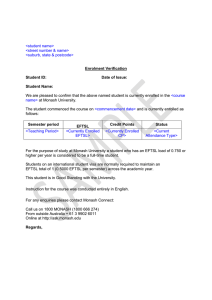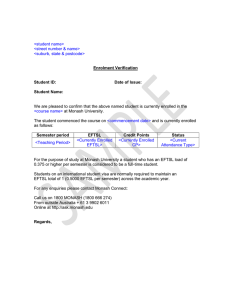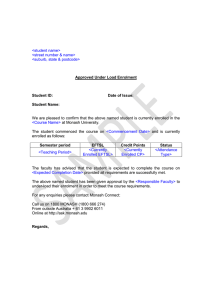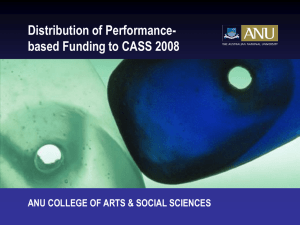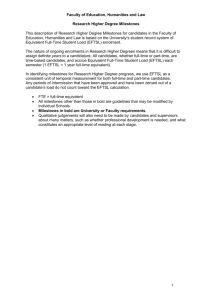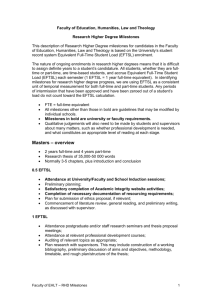e While the School’s workload policy seeks to establish key operational... UNE Business School
advertisement
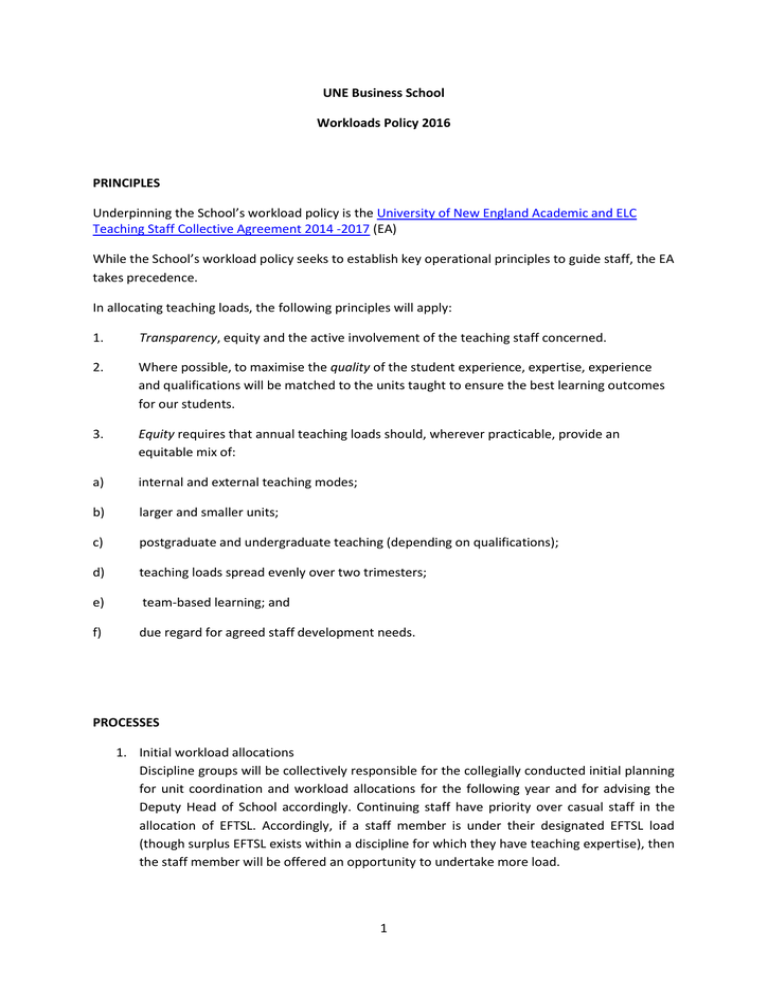
UNE Business School Workloads Policy 2016 PRINCIPLES Underpinning the School’s workload policy is the University of New England Academic and ELC Teaching Staff Collective Agreement 2014 -2017 (EA) While the School’s workload policy seeks to establish key operational principles to guide staff, the EA takes precedence. In allocating teaching loads, the following principles will apply: 1. Transparency, equity and the active involvement of the teaching staff concerned. 2. Where possible, to maximise the quality of the student experience, expertise, experience and qualifications will be matched to the units taught to ensure the best learning outcomes for our students. 3. Equity requires that annual teaching loads should, wherever practicable, provide an equitable mix of: a) internal and external teaching modes; b) larger and smaller units; c) postgraduate and undergraduate teaching (depending on qualifications); d) teaching loads spread evenly over two trimesters; e) team-based learning; and f) due regard for agreed staff development needs. PROCESSES 1. Initial workload allocations Discipline groups will be collectively responsible for the collegially conducted initial planning for unit coordination and workload allocations for the following year and for advising the Deputy Head of School accordingly. Continuing staff have priority over casual staff in the allocation of EFTSL. Accordingly, if a staff member is under their designated EFTSL load (though surplus EFTSL exists within a discipline for which they have teaching expertise), then the staff member will be offered an opportunity to undertake more load. 1 2. Allocation of workloads The EFTSL band for the UNE Business School is 25-33 EFTSL. Staff will be allocated the relevant EFTSL allocation for the coming year based on their research productivity, as per the Table contained in Appendix 1. Formal service roles in the School will be recognised with specific EFTSL allocations detailed in Appendix 2. Early Career Researchers (Levels A or B, and within 5 years of their PhD) will be allocated 25 EFTSL for the first two years of their appointment as they seek to establish their research activity. 3. Coordination duties are the responsibility of continuing staff members All units will be coordinated by a continuing staff member, except for special cases approved in writing by the Head of School arising from the demonstrable difficulty of fulfilling this requirement. 4. Online teaching hours calculations For the purpose of calculating workload for team teaching and casual assistance on-line teaching will be counted as face-to-face teaching on the basis of one session for each 30 external students with the first such session being equal to three hours work (one hour of delivery and two hours of associated working time). The teaching of second and subsequent groups of 30 students will be considered equal to two hours work (one hour of delivery and one hour of associated work). 5. Announcement of workloads The Deputy Head of School will circulate workloads as soon as practicable after each trimester’s census dates. The workloads would be actual for the current trimester, prospective for the remaining trimesters and would also specify any teaching not yet covered. The workloads of casual staff will be published separately as soon as practicable after the trimester 3 census date. 6. Carryover of excess load It is expected that reasonable steps are undertaken to manage EFTSL load consistent with the allocated load and there will normally be no carryover of load from one year to the next. Where there are exceptional circumstances when staff cannot find colleagues or appropriate casual teachers to absorb their forecast excess load, despite strenuous efforts to do so, carryover will be agreed with the Head of School. 7. SSP Staff who qualify for SSP and are granted one trimester or two trimesters SSP will have their annual teaching workload reduced by 50 per cent. The SSP will be taken in one of the staff member’s two teaching trimesters. The remaining 50% of workload will be taught in the remaining one teaching trimester. 2 8. Adjustments for LSL Staff who take Long Service Leave (LSL) will have their teaching workloads reduced by the proportion of the workload period that is occupied by their LSL. For example: a staff member who takes ten weeks of LSL will have their teaching workload reduced by 10/48 (i e. 21%). 9. HDR supervision while on leave While on SSP or LSL, whatever provisions regarding HDR supervision are agreed by the HoS and PDVC, those same provisions will apply to the staff member’s workload. It is the responsibility of the staff member who is taking SSP or LSL to clearly inform the Deputy Head of School of arrangements agreed to, regarding HDR supervision. If a staff member chooses to continue supervising HDR students while on SSP or LSL, the EFTSL that would normally accrue from such teaching will not be included in that staff member’s workload calculation. 10. EFTSL value of HDR supervisions and Special Topics, Honours dissertations and Masters minor dissertations Supervision of full time Honours and Masters dissertations will be allocated one EFTSL. Doctoral supervisions will be allocated two. These allocations apply only during the agreed enrolment period and exclude any leave periods taken by the student during their years enrolled. Less than full time supervision will be allocate EFTSL Pro rata. EFTSL arising from enrolments in Special Topics, Honours dissertations and Masters minor dissertations units will be allocated to the staff member who actually does the teaching. 11. Appeal procedures Academic staff have two weeks to appeal their workload allocation. In the first instance, a meeting will be held with the Deputy Head of School to try to resolve the situation. If the staff member and the Deputy Head of School cannot reach agreement, an appeal should be directed to the Head of School who may consult the School Executive Committee before making a ruling or may summarily decide the issue, depending on the factors preventing agreement. Thereafter, disputes about workloads will be resolved using the Dispute Settlement Procedures of the UNE Academic and ELC Teaching Staff Collective Agreement 2014-17. 12. Annual Policy Review The School Workloads Committee will review this Policy annually so as to produce a draft Policy for the subsequent year before 1st December of the current year. 13. The appended tables are part of this policy 3 Appendix 1 Impact of Research Activity on Workloads Research Workload Model UNE Business School, 2016 The calculation of research productivity for the purpose of workload allocation is based on the quantity and quality of publications produced over the previous three years. The maximum teaching load of 33 EFTSL can be reduced by up to 8 EFTSL depending on research productivity. This means that the load for the most productive researchers is 25 EFTSL. The expectation of research productivity of staff increases with their academic level. The bar is set highest for level E and it decreases proportionally to salary for levels D, C and B. Points assigned to research outputs The points assigned to a publication are adjusted according to the number of authors and the quality of the output. The proportion (X) of a publication assigned to an author is calculated based on the number of authors (N) as X = (1 + 1/N)/2. This method gives higher weight to single-authored outputs but still encourages collaboration by introducing only a small and decreasing penalty for each additional author. The author proportion for each publication is then multiplied by the number of points accrued by the output type, as defined in Table 1. Table 1. Points assigned to each academic level per publication type under the research workload model (Model). Output type Points Journal papers: A* 10 A 5 B 2 C 1+ Book 5 Edited Book 1 Book Chapter 1 Conference paper 0 Unranked paper 0 + Note: Level E staff do not receive credit for C journal papers. The total points assigned to a staff member are given by their research outputs over the last three years. These points are converted to EFTSL allowances according to academic level as explained below. 4 The research workload formula The formula used to calculate EFTSL allowances is: P Ai Amax min i ,1 Hi Where: Ai is the EFTSL allowance for staff member i. Pi is the number of research points obtained by the staff member Hi is number of points at which i receives the maximum allowance depending on academic level (see Table 2). Amax is the maximum EFTSL allowance given for research activity, 8 EFTSL under the current scheme. This formula results in a linear increase in the allowance received as the number of research points increases, but it is truncated at the maximum allowance Amax = 8. The number of research points required to receive the maximum allowance (H) is currently set at 25 for a level E. This could be achieved by producing five A journal papers over three years or other combinations, such as 2.5 A* papers or 12.5 C papers (see Table 1). The maximum allowance received by a staff member (Hi) is adjusted relative to the benchmark of 25 according to relative salary as illustrated in Table 2. Table 2. The number of research points at which staff members are considered highly productive (Hi) based on their academic level. Hi is calculated by multiplying the salary ratio times the maximum Hi value (25). Academic level B C D E Salary Salary ($1,000) ratio 93 0.58 112 0.70 132 0.82 161 1.00 Hi 14.5 17.4 20.4 25.0 Applying the formula The actual EFTSL load is calculated by subtracting the allowance (Ai) from the maximum load of 33. Figure 1 shows the results of applying the formula. Research-inactive staff (those with zero points) receive the full teaching load of 33 EFTSL. The workload of research-active staff decreases linearly depending on their research productivity, but the decrease is fastest for level B and slowest for level E, reflecting relative research productivity expectations. The formula was applied to UNEBS staff for 2013-2015 based on data extracted from the RIS worksheets. The distribution of loads is presented in Figure 2. The detailed results are presented in the Appendix. An Excel file is available to undertake these calculations. 5 B C D E 33 32 EFTSL Load 31 30 29 28 27 26 25 0 5 10 15 20 25 30 Research Points Figure1. The workload assigned according to academic level and research outputs. Parameters: Number of staff EFTSL Loads 20 18 16 14 12 10 8 6 4 2 0 25 26-29 30-32 33 EFTSL Range Figure2. Frequency distribution of workloads assigned to UNEBS staff based on 2013-2015 research outputs. 6 Appendix 2 Formal service roles recognised through EFTSL allocation (To be completed when the UNE Business School strategic plan is finalised) Role Deputy Head Chair, Teaching and Learning Committee Chair, Research and Research Training Committee Course Coordinators for cluster of courses Partnerships and Business Development manager 7 EFTSL recognition 67% 50% 33% 9-15 EFTSL depending on size of cohort 18 EFTSL
